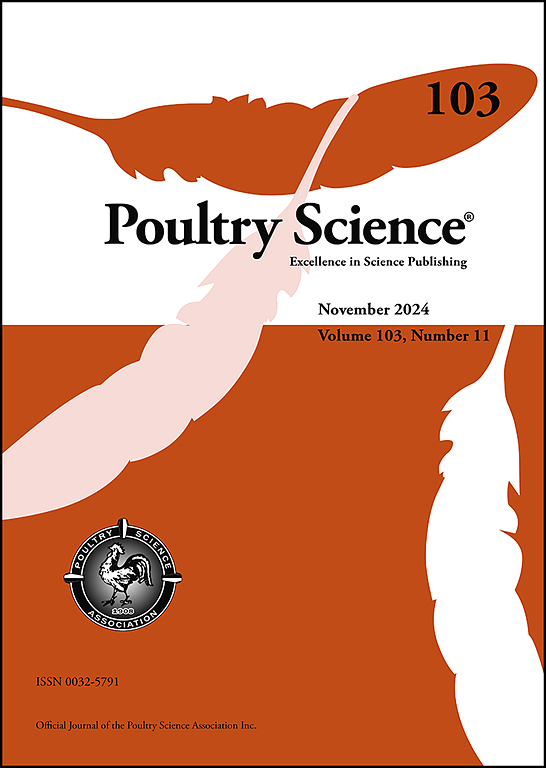Synergistic transcriptomic and metabolomic analyses in Zi geese ovaries with different clutch lengths
IF 3.8
1区 农林科学
Q1 AGRICULTURE, DAIRY & ANIMAL SCIENCE
引用次数: 0
Abstract
The clutch is defined as consecutive days of oviposition. Clutch length is an index that reflects ovulation persistence, and is highly correlated with egg production in birds. To identify the genetic markers associated with clutch length in geese, two consecutive experiments were conducted. In the first experiment, 200 Zi geese were selected, all 230 days old, were selected from the same batch and raised individually in the same environment. Data of egg-laying and clutch traits were recorded. After the laying period, three geese with the longest clutch lengths were selected to form the length clutch group (LCG) and three geese with the shortest clutch lengths were formed the short clutch group (SCG). In the second experiment, the ovaries of six geese were collected for transcriptomic and metabolomic analyses. The results showed that large clutch length (LCL) and average clutch length (ACL) were positively correlated with egg number (EN) (P < 0.01; r = 0.63 and 0.60, respectively). Large clutch number (LCN) was significantly correlated with the peak egg number (PEN) (r = 0.58, P < 0.01) and EN (r = 0.60, P < 0.01). EN, LCN, LCL, and ACL showed significant differences (P < 0.01) between the two clutch length groups. Transcriptomic analysis identified 424 differentially expressed genes (DEGs). Functional enrichment analysis revealed that these DEGs were mainly involved in neuroactive ligand-receptor interactions, ovarian steroidogenesis, and calcium signaling pathways. Further, AVPR1A, FGF14, and LHCGR were predicted as the key genes regulating LCL. Metabolomic analysis identified 349 differential metabolites (DMs) in both the positive and negative ion modes. Pyruvate, isocitric acid, D/L‑serine, 3-phospho-d-glycerate, succinate, glycine, and glutamic acid were identified as the key metabolites mainly enriched in the signaling pathways of the TCA cycle. Integration of transcriptomic and metabolomic data revealed critical gene-metabolite pairs, including ACSL4–phosphoenolpyruvate, implicated in LCL regulation. In summary, this study provides new insights into the genes and molecular markers affecting LCL in Zi geese.
不同卵龄子鹅卵巢的协同转录组学和代谢组学分析
一窝卵被定义为连续几天的产卵。孵蛋时长是反映鸟类排卵持续时间的指标,与产蛋量高度相关。为了确定鹅产蛋长度相关的遗传标记,进行了两次连续试验。试验1选用同一批次230日龄的紫鹅200只,在相同环境下单独饲养。记录了产蛋和窝卵性状的数据。产蛋期结束后,选取离合长度最长的3只鹅组成长离合组(LCG),离合长度最短的3只鹅组成短离合组(SCG)。试验二采集6只鹅的卵巢进行转录组学和代谢组学分析。结果表明:大窝长(LCL)和平均窝长(ACL)与蛋数(EN)呈显著正相关(P <;0.01;R分别为0.63和0.60)。大窝数(LCN)与峰值蛋数(PEN)显著相关(r = 0.58, P <;0.01)和EN (r = 0.60, P <;0.01)。EN、LCN、LCL、ACL差异有统计学意义(P <;0.01)。转录组学分析鉴定出424个差异表达基因(DEGs)。功能富集分析显示,这些deg主要参与神经活性配体-受体相互作用、卵巢类固醇生成和钙信号通路。进一步预测AVPR1A、FGF14和LHCGR是调控LCL的关键基因。代谢组学分析鉴定出349种正负离子模式的差异代谢物(DMs)。丙酮酸、异柠檬酸、D/L丝氨酸、3-磷酸- D -甘油、琥珀酸、甘氨酸和谷氨酸被确定为主要富集于TCA循环信号通路的关键代谢物。转录组学和代谢组学数据的整合揭示了关键的基因-代谢物对,包括acsl4 -磷酸烯醇丙酮酸,与LCL调控有关。综上所述,本研究为紫鹅LCL的基因和分子标记提供了新的认识。
本文章由计算机程序翻译,如有差异,请以英文原文为准。
求助全文
约1分钟内获得全文
求助全文
来源期刊

Poultry Science
农林科学-奶制品与动物科学
CiteScore
7.60
自引率
15.90%
发文量
0
审稿时长
94 days
期刊介绍:
First self-published in 1921, Poultry Science is an internationally renowned monthly journal, known as the authoritative source for a broad range of poultry information and high-caliber research. The journal plays a pivotal role in the dissemination of preeminent poultry-related knowledge across all disciplines. As of January 2020, Poultry Science will become an Open Access journal with no subscription charges, meaning authors who publish here can make their research immediately, permanently, and freely accessible worldwide while retaining copyright to their work. Papers submitted for publication after October 1, 2019 will be published as Open Access papers.
An international journal, Poultry Science publishes original papers, research notes, symposium papers, and reviews of basic science as applied to poultry. This authoritative source of poultry information is consistently ranked by ISI Impact Factor as one of the top 10 agriculture, dairy and animal science journals to deliver high-caliber research. Currently it is the highest-ranked (by Impact Factor and Eigenfactor) journal dedicated to publishing poultry research. Subject areas include breeding, genetics, education, production, management, environment, health, behavior, welfare, immunology, molecular biology, metabolism, nutrition, physiology, reproduction, processing, and products.
 求助内容:
求助内容: 应助结果提醒方式:
应助结果提醒方式:


